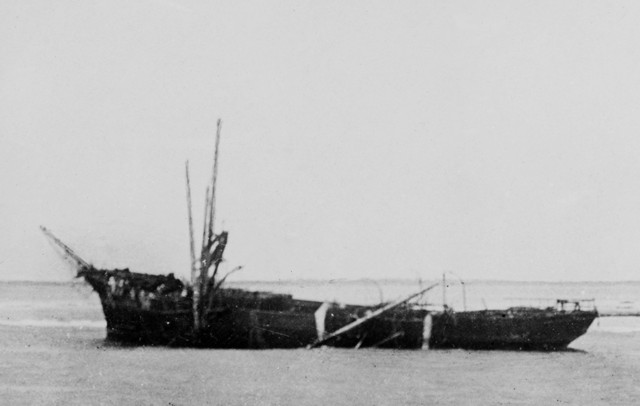December 29, 2012

A proud ship, and one that well-served its masters into the 20th Century. It was something of a pleasant-looking anachronism as World War I began... a ship of sail in a world of Dreadnaughts and armored cruisers. However, as the First Great Mistake got cranking, the United States was neutral and non-aligned, and King Cotton had to be moved, so the Pass of Balmaha kept at it... until June of 1915.
It was then that she set out for Arkhangelsk with a full load of cotton for the Russian war effort; a long trip when one is entirely reliant on the wind. It took her a month to get from New York to the coast of Scotland, where she encountered the Royal Navy's auxiliary cruiser Victorian.

Perhaps better termed an armed merchantman, the Victorian's captain was apparently in a nasty mood on that day in late July, or perhaps he was thrilled beyond the ken of normal beings by stumbling across a vessel that his could dominate. Either way, he ordered the Pass of Balmaha to heave to and prepare to receive a boarding party. Her cargo was inspected for contraband, and though none was found, the Victorian's captain decided that this sailing vessel was bound for Germany, not Russia, and thus must be impounded before her dangerous load of cotton could aid the opponents of The Crown. A prize crew of one officer and six marines was put upon the Pass of Balmaha and the ship instructed to sail for the Orkneys. The British officer, undoubtedly a young and enthusiastic ensign, struck the American flag and replaced it with the Union Jack. The American captain protested, noting that this made his ship a target, but the complaints were denied. And then the next day, the U-boat came.


The Seeadler was designated an auxiliary cruiser and set loose on the unsuspecting merchant fleets of the Allies on December 21, 1916. For the next 225 days, she took fifteen vessels ranging from 364 tons to 3609 tons. During these exploits, no members of the Seeadler's crew were injured, and only one man of the prizes was slightly injured, and that by accident. More often than not, the popup guns were never used. As more and more Allied vessels were being told to keep an eye out for a tri-masted windjammer in the Atlantic, the captain of the Seeadler decided to make his way to the Pacific ocean, where he continued his predations until August 2nd, 1917. On that day, while anchored in the French Society Islands, the Seeadler was washed upon a reef and mortally wounded.

Her entire crew made it off safely. The captain and six others sailed off in a 32 foot boat for the Fiji Islands, attempting to find help. Instead, they were interred. The remaining 58 crewmen captured a small French schooner, the 16th prize of the Seeadler, and sailed to Easter Island, where they ran aground and were later interred by Chilean authorities.
But the story was not yet done. In late 1918, the owners of the Pass of Balmaha headed to the French Society Islands to see if their possession, taken from them by two different nations, could be salvaged. Alas, it could not and was left on the reef. It later fell off the reef and sank, where it is well within scuba range.
Posted by: Wonderduck at
10:25 PM
| Comments (6)
| Add Comment
Post contains 957 words, total size 7 kb.
Posted by: brickmuppet at December 29, 2012 10:33 PM (vp6an)
Nice, merchant cruisers/commerce raiders of WW1.
I always been partial to the RMS Carmania and her encounter with SMS Cap Trafalgar myself, especially since said encounter was the main topic of the opening chapter of The Great War At Sea.
Then we have the interesting end of the commerce raider Michel in Big Mistake Number Two.
Posted by: cxt217 at December 29, 2012 11:07 PM (A2Cof)
Posted by: Steven Den Beste at December 29, 2012 11:14 PM (+rSRq)
Posted by: jon spencer at December 30, 2012 08:40 AM (hFoyt)
CXT, I hadn't heard of the RMS Carmania before... amusing that she and the Cap Trafalgar were disguised as each other!
Posted by: flatdarkmars at December 31, 2012 08:09 PM (I55Es)
As I mentioned, I first read about Carmania versus Cap Trafalgar in the school library's copy of A.A. Hoehling's The Great War at Sea: History of Naval Action, 1914-18, which had its first chapter dedicated about the battle between the two ships and the events leading up to it. Robert Massey was probably still in the early stages of writing Castles of Steel (If that.), at the time, which probably does a good job of dating me...
They are not merchant cruisers (Though the latter was armed almost as heavily as one.) but the Ondina and the S.S. Stephen Hopkins also had run ins with merchant cruisers/commerce raiders, with interesting results.
...And if this is the same Blaine Pardoe as I am thinking - sounds like the guy who wrote some novels and sourcebooks for Battletech back in the day, which has its own share of interesting stories.
Posted by: cxt217 at December 31, 2012 11:37 PM (or2/m)
46 queries taking 0.6328 seconds, 167 records returned.
Powered by Minx 1.1.6c-pink.









